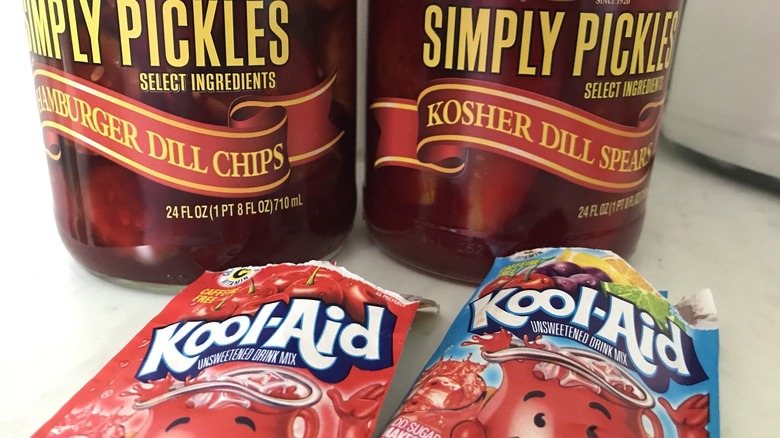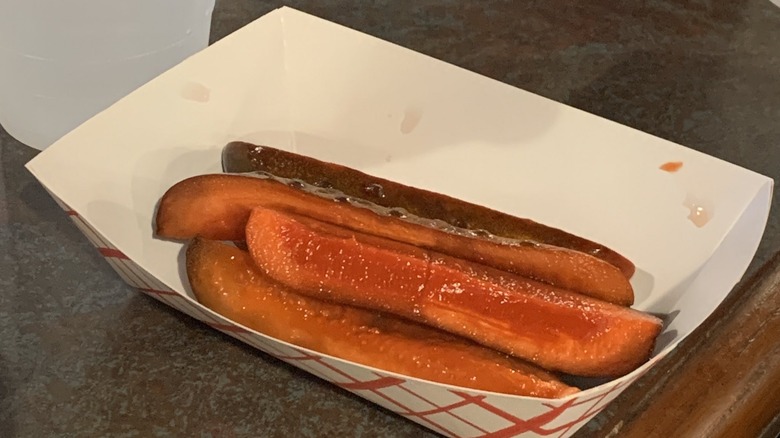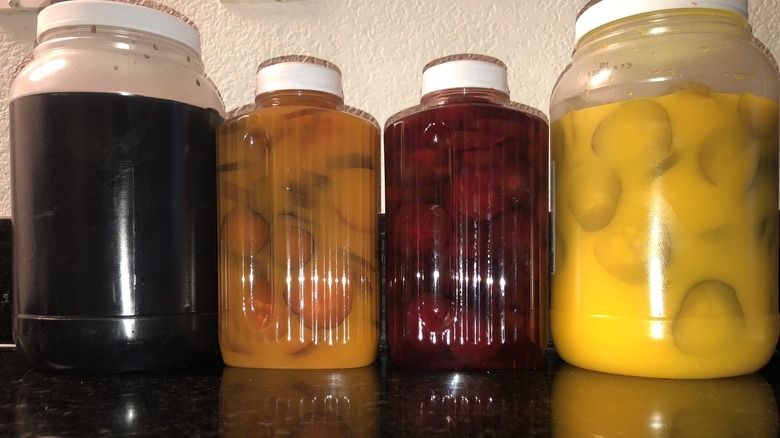What Are Kool-Aid Pickles And What Do They Taste Like?
Orange juice and toothpaste. Ketchup on hard-boiled eggs. Mayonnaise on pizza. The list of bizarre stomach-churning food combinations goes on and on. Sometimes, the result of trying something like macaroni-and-cheese-flavored ice cream ends in you losing your appetite — not to mention what you ate that morning — but on some occasions, these "colorful" food combinations can turn out to be an unexpected treat. You could munch on salty chocolate-covered potato chips, dip your French fries into your milkshake, or dunk your pizza crust into ranch dressing, and strike culinary gold.
One such combination that is said to be weirdly good is the humble Kool-Aid Pickle (or the Koolickel, if you want to impress your friends!). Soaked in a Kool-Aid/pickle juice/sugar brine for a few days, these spears show off stunningly bright colors and are said to have a tangy, sour, and sweet taste to them (via Pure Wow). If you're willing to brave the unknown, break out your pickle jars and Kool-Aid pouches, and discover just what makes this dill delight so enticing.
Where Does The Koolickle Come From?
The Kool-Aid Pickle is said to have it's roots in the South — more specifically, the Mississippi Delta region, according to The New York Times. It's unknown just who exactly invented the Kool-Aid Pickle, though the article does put a rough estimate that "fans" of the Koolickle appeared some time after Bill Clinton entered the White House.
Fans of the Koolickle are indeed prominent in the Delta region. The New York Times reported that the colorful pickles are sold at venues ranging from convenience stores to school fundraisers. Children seem to love the sweet-and-sour snack, comparing it to "Hot Cheetos in ice cream" and showing how to enjoy a Kool-Aid Pickle on the end of a Blow Pop for double the sweet-sour flavors. Such is the popularity of this peculiar pickle that local elders around the town of Indianola sell them from their own homes for children to enjoy. A shop owner, Hugh Davis of the Stephensville Mini-Mart, gives perhaps the most solid answer about where Koolickles came from: "It's the kids who've done it. They'll create a line of food for you; they'll dab a little something here and there and make it their own. They're good at inventing."
Making Your Own Koolickles
There's a good chance you're not going to find any Kool-Aid pickles in a big box store like Walmart or Target, so you'll just have to depend on the good old-fashioned method of pickling with Kool-Aid yourself. But wait, you cry, I know how to make Kool-Aid, but I don't know how to pickle anything! Fortunately for you, dear reader, there are a few recipes that don't require you to know the ins-and-outs of the pickling process.
Taste Of Home, for example, gives a simple recipe: Take a jar of your favorite pickles (chips, spears, etc) and drain the brine into a separate container. Add your favorite Kool-Aid powder into the jar of pickles, and if it's unsweetened or you really don't like sour stuff, add some spoonfuls of sugar. Add the brine back into the pickle jar, cover tightly, and shake until well combined. The recipe recommends curing the pickles in the fridge for a week or so to get maximum color and flavor. The process isn't very complicated, and it allows plenty of room for experimentation. Have you ever tried a Blue Raspberry pickle? Can you make tie-dye Kool-Aid Pickles? It's all up to you!


